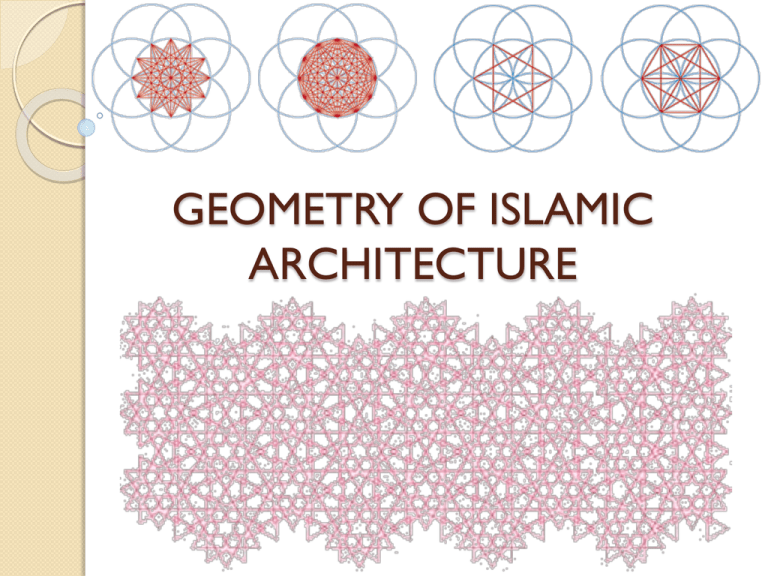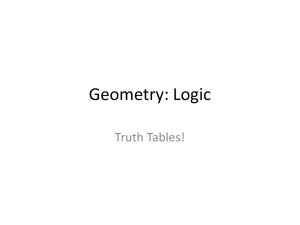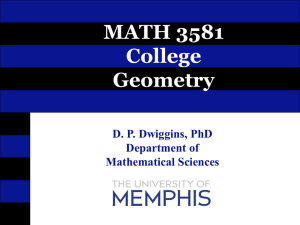Geometry in Islamic Architecture
advertisement

GEOMETRY OF ISLAMIC ARCHITECTURE INTRODUCTION •Four types of ornamentation can be found in Islamic art: o calligraphy, ofigural forms (human and animal), o vegetal motifs, and o geometric patterns. •Geometry is one the most important elements of Islamic art. “Star shapes and polygons appear in all the arts and provide a source of much architectural decoration… geometric shapes are highly versatile and can be extremely complicated.” •From the simple polygons and rectangles used as framing devices to the highly complex interlaces of stars and irregular polygons. •The four basic shapes, or "repeat units," from which the more complicated patterns are constructed are: ocircles and interlaced circles; osquares or four-sided polygons; othe star pattern, ultimately derived from squares and triangles inscribed in a circle; omultisided polygons. HOW IS GEOMETRY SEEN TO BE SPIRITUAL? •Because circles have no end they are infinite and so they remind Muslims that Allah is infinite. •Complex geometric designs create the impression of unending repetition, and this also helps a person get an idea of the infinite nature of Allah. •The repeating patterns also demonstrate that in the small v can find the infinite ... a single element of the pattern implies the infinite total. •The repeated geometric patterns often make use of plant motifs, and these are called arabesques. • Stylised Arabic lettering is also common •The Circle and it is centre at which all Islamic patterns begin.It emphasizes one god. •The triangle symbolises human and the principles of harmony. •The square is the symbol of physical experience and the physical world or materiality. •The hexagon symbolises heaven. •The star symbolises the spread of Islam. BASIS OF GEOMETRY The basic methods by which 3, 4, 5, 6, 8 and 10 point patterns can be constructed using only a straight edge and compass. Constructions of 7 and 9 point patterns can be approximated. From the geometrical constructions mentioned above generally, patterns with a greater complexity can be constructed. Patterns with 12, 14, 15, 16, 18 and 20 are readily established. THREE POINT GEOMETRY Three point geometry can be constructed from six point geometry. Discussed in six point geometry. FOUR POINT GEOMETRY •Four point geometry is one of the easiest geometries to set out. • It is often used in counterpoint with circular geometries. •It is constructed by raising a perpendicular from the centre point of a horizontal line to the point where it cuts a circle described from that point, and joining the four points of intersection. • Further sub-divisions into eight point geometry can be constructed by sub-dividing the sides of the square. FIVE POINT GEOMETRY Five point geometries are slightly more difficult to construct, but can be relatively easily developed. They have an additional interest in that they are similar in proportion to the geometry derived from the Golden Section, having proportions between the minor and major chords of the five points circumscribed by a circle, of 1:1.618. From the five point geometry, ten point geometries are easily developed and form the basis for many of the more attractive patterns in Islamic decoration. SIX POINT GEOMETRY Six point geometry is by far the easiest geometry to construct, requiring only a simple form of compass to create the basis for accurate three-, six- and twelve-pointed forms. In this ,seven-circle from the six-point geometry construction and shown how the basic pattern lines evolve. The first illustration shows, in first figure, the basic circle rose with, in second figure, the addition of lines joining the intersections of the surrounding circles with the basic circle to create a regular hexagon. By joining different points different patterns are found as shown above •Dividing of a single circle, the more common basis for a pattern is a simple grid, here the development of the circle suited to six-point geometrical patterning. Even in this the eye finds it difficult to rest, but is continually moving around the circles. The addition of straight lines just develops and guides this movement. •A slightly different development of diagram and is repeated here to show how a relatively simple pattern based on six-pointed geometry might be developed. The basic grid shown in the six-point, has been turned 30° counterclockwise and a number of straight construction lines selected on which the pattern has been produced. TAJ MAHAL •Called a monument to love, the Taj Mahal has also been called "India's most famous and finest example of architecture. • We could call it a monument to symmetry. •From the formal gardens divided into four sections, to the tomb 900 feet from the entrance, the four minarets continue this symmetrical theme. •The minarets next to the Taj Mahal are 41.1 meters or 137 feet high and are cylindrical columns with angles. •Located at each of the corners of the raised marble plinth the minarets repeat the right angles that are an obvious part of the Taj Mahal. •The main structure is cubical. •The windows have arches which comes to a point. Painted geometry in the ceiling •The complex is set around a large 300meters square charbagh,a Mughal garden. Interior of dome, showing inlaid geometric decoration •The central circle at the base arches upward to create the famous onion dome. •The Taj Mahal is a fine example of geometry. •The rectangular reflecting pool mirrors the pools in each of the four gardens and makes your eyes follow along parallel lines to the tomb's entrance. •The intersecting perpendicular lines continue to create right angles in each of the four sections which are subdivided into another four squares. •The doorways are rectangular in design with semi-octagonal angles. •The room that the tombs are placed is octagonal. As we look at the Taj Mahal, there are multiple lines of symmetry. •The total effect combines to make one of rhythm and harmony. Tomb of I'tmad-Ud-Daulah (Eyteymaaduddowlah) •'Decagonal and QuasiCrystalline Tiling in Medieval Islamic Architecture‘ •Islamic mathematicians had made a breakthrough in the geometry that made it possible to create this extraordinary complex with patterns having a 10-fold rotational symmetry. •A set of five tile types, now called ‘girih tiles’, in any combinations serve as templates for incorporating with the existing decagonal symmetry. •I'tmad-Ud-Daulah is the tomb of Mirza Ghiyas Beg and his wife Asmat Begum. •He was father of the famous 'Nur- Jehan' and grandfather of 'Mumtaz -Mahal' of the famous Taj Mahal fame. •He was made Vazir (Prime Minister) after Nur Jehan's marriage with Jehangir in 1611. • He held the title I'tmad-Ud-Daulah (The Lord Treasurer). •He died at Agra in 1622, a few months after his wife's death. Nur Jehan built this tomb for her parents between 1622 and 1628. •The tomb is situated on the Eastern bank of the river Yamuna at Agra. It is located in the centre of a char-bagh (four quartered garden), with the usual enclosing walls and side buildings. •The most important aspect of this tomb is its polychrome ornamentation. •Exterior walls of the tomb have been covered with beautiful floral and geometrical designs. A modest attempt to draw manually a pattern with 10-fold rotational symmetry using in combination decagonal, hexagonal and bow girih tiles







